In the first part of the chapter, we spoke of a codified framework made up of a web of enigmas tightly interconnected among them. In order that these, that are isolated and unique, may determine a coherent structure, they must obey certain rules that generate order and harmony. We know that a Code is a symbolical message deliberately constructed through a combination of allegorical images. If we find that the functioning mechanism of the Codes obeys certain principles, we might speak of the presence of schemes, or Laws .
Let us return in our minds to the Codes illustrated before. The analysis of the two cards Hanged Man-World had shown a total contrast between the two Arcana: there was, then, an antithetical scheme. In the second proposed Code as well, the Lover-Judgement, we had espied certain aspects tied to the same mechanism:
Hanged Man-World → Antithesis
Lover-Judgement
→
Antithesis
Furthermore, in both cases these Codes allowed emergence from Dualism. However, we also added that Dualism is ubiquitous. And if at the same time, the inversion scheme were applicable in a more ample and general manner? Moreover, if there were a rule in that sense? The reply is affirmative: and it refers precisely to one of the Laws, the principles, at the basis of the modalities of expression of a part of the Codes. This rule, called the Law of Antithesi s, states that:
When two elements, in the same card or in two different cards, are inverted in their meanings, a Code is created. The inversion, from a graphic or a conceptual point of view, may refer to a symbol or a group of symbols. The deciphered Code may be object of an interpretation for the individuation of a teaching.
We propose a simple and immediate example to illustrate the definition, calling attention to the Arcana at the extreme ends of the 3x7 Diagram, the Magician and the World, who begin and finish the numbered series of the Majors, because the Fool, as we said before, numberless and therefore out of sequence. Observing the two cards, is there something (in opposition) that would strike us?
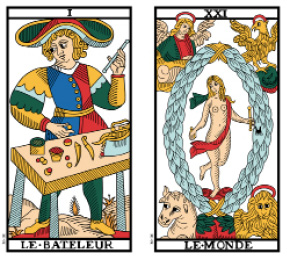
Fig. 16
Magician - World
In the Magician we note immediately a large rectangular-square form, the table on which rest his tools, while in the World, as we know, exists the symbolism of the circle, represented by the great oval form. Here again is the application of this Law: through the discovery of a small enigma, we have evidence of a teaching (in this case, terrestrial-celestial Dualism). 69 From this, as always, we may draw other conclusions. The Magician, for example, is associated with a specific letter of the alphabet, the A, not only because it is in first position (as is the A in the alphabet) but above all for a subtle connection with its features with the Hebrew letter A, Aleph. It is enough to observe the form created by the arms and the trunk of the personage, and compare it with the letter itself:
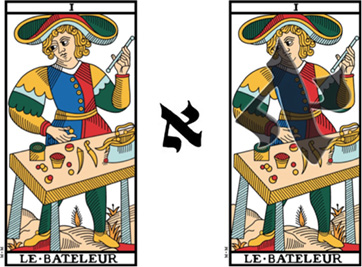
Fi g . 17
Magician - Alef
The World, instead, describes the letter O, strongly suggested by the oval. Thus, in this second case as well, we find a meaning of opposition: the A and the O, the Greek alpha and omega which, as we remember from their presence in the card of the Wheel, are cited in Christianity as the beginning and the end, therefore opposites…In short, the presence of reiterated models leads to the formulation of a Law. The difference between this and a Code, as a general principle, is that this last is an isolated event, while the first is a scheme that repeats itself:
Code: unique and isolated event
Law:
scheme that repeats.
Expressed in another manner, when the Codes, which manifest with different characteristics every time, with diverse designs and symbols, express themselves by analogous functioning mechanisms, we must conclude that they are disciplined and regulated by the same Law. This is a very important aspect for understanding the functioning of the Tarot. The presence of Codes indicates that there is a fragment of a teaching to be discovered. The Laws lead towards the understanding of the order existing in the Coded Structure , created by Codes, and depositary of general teaching. The interaction of the two, like a device with millimetrical gears and cogs, allows a discovery that, in a gradual motion, illustrates the sense of the incredible Metaphysical Machine called Tarot . Let us imagine to have lived all our lives, from birth, in an underground cave, without ever seeing the light of day. At a certain point, because of a change in our conditions, we find ourselves on Earth’s surface, where we experience for the first time a simple yet splendid spectacle: a sunrise. If no one explained this to us, certainly, after this first experience, we might ask ourselves if this episode were to consider an isolated event. We might then decide to verify this, going to sit every day in the same place where we saw that marvel the first time, in order to possibly observe it again. Thus, gradually, over time, we would realize that the heavenly body that gives light and warmth reappears periodically, every time. At this point, even unknowingly, we would have found it (for us, who already knew), the Law most taken for granted: the sun rises every morning. Returning to the Tarot, we may say that the presence of a first Code is comparable to the discovery of the sunrise on that first morning. When we find a second Code which follows the same mechanism, we have a second day of sun. If, one by one, we find many other features of the same system of functioning, we will comprehend the presence of an actual Law: we learn, that is, that the sun rises every morning . If, then, to remain in the Metaphor, we were not yet sated and wished to understand the why of this rising, we would need to seek other codes, other laws, and at that point we would find ourselves on the Path which teaches us that the rising of the sun is connected to terrestrial rotation. Let us continue then, along this Path...
It is not easy to approach the scientific dimension of the Tarot, in the current epoch totally unknown. For this reason, we have chosen to propose an exercise for this new subject as well. Let us observe the cards listed here, attempting to discover if there is something in particular which, in every couple, draws the attention:
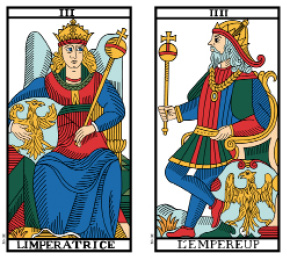
Fig. 18
Emperess- Emperor
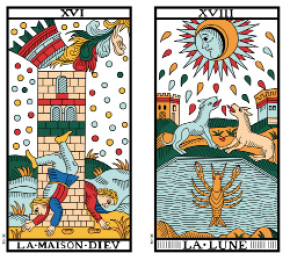
Fig. 19
House of God – Moon
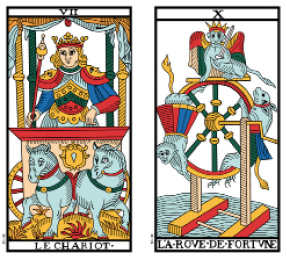
Fig. 20
Chariot – Wheel of Fortune
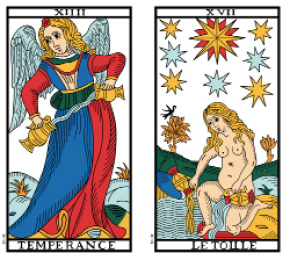
Fig. 21
Temperance - Star
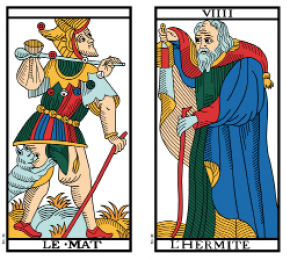
Fig. 22
Fool - Hermit
In all of these cases, the list of which might have been decidedly longer, is revealed a constant characteristic: a symbol, which, although with specific differences, appears in both the Arcana. In fact, in order, we find:
Twice the eagles
Twice the towers
Twice the wheels
Twice the earthenware jars
Twice
the red wands
Thus in every couple there is the same element, which appears at least twice. This is a scheme that repeats , although we now know that this is definable as a Law. How might we baptize this specific rule? The term that occurs most spontaneously is The Law of Duplicity , a particular case of the Law of Multiplicity , one of the most potent pilasters on which is based the Language of the Tarot.
In the preceding chapter we introduced the Law of Difference which, let us remember, states that, finding ourselves facing two similar symbols, it is necessary to search also for that which differentiates them. In any case, why do we meet so many similar elements in the Arcana? In a conversation, or to emphasize our own opinion, we frequently reiterate a concept of which we are particularly fond. Through repetition, concepts are consolidated and confirmed. The same is true for the Tarot which re-proposes certain elements, with the purpose of drawing attention to the fact that Codes exist (and we have already partially alluded to this in the case of the two eagles), as also to accentuate their importance. Let us evaluate some cases in order to better comprehend this dynamic.
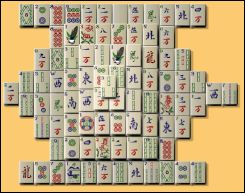
Fig. 23
Mah-jong
Let us observe the staff present in the Fool and the Hermit, the last couple of cards of our list. Experts have always admitted that they noticed it, have always hypothesized that behind its double presence there was nothing particular to discover. However, when one is conscious of the presence of the Coded Structure , our attention and our manner of observing must change. The fact of finding the same element, only in these two cards among all the 78 that make up the deck, obliges us to ask if there is a connection between them. Perhaps the Tarot mean to suggest that there is something to discover?
Mah-jong , an amusing game of Chinese origin, consists in finding couples of tiles of the same sort, with the same monogram. The purpose is to gradually take them off the board, freeing those underneath in order to victoriously win the game. Thus, the red staff, as if it were a monogram, indicates that the Hermit and the Fool are tiles in relation with each other, not in order to take them away, but to “liberate” a message…This symbol is there precisely to tell us that between two Arcana there exists a relationship.
Let us consider them again from another point of view and let us attempt to understand if this connection truly exists. Observing the Fool attentively, we see that he might represent a pilgrim or a disciple following a road. The idea of a pilgrim, of one who begins a journey, is deducible from the iconography of the image. Among its distinctive traits, we realize that it is the only card in which real movement is expressed, not simply the idea of movement, which might be expressed by other illustrations, as the wheel. Furthermore, it is the only blade in which the gaze of the protagonist is turned upwards, as if he were seeking his ideal in the heavens. On the other hand, is not the goal of a spiritual pilgrimage, at least metaphorically, the Heavens?
The Hermit, on the contrary, is old, immobile, and with a lamp in hand in the act of making light , 70 and might be the elderly Teacher who awaits the Fool, his disciple. We may also deduce his condition of waiting by the illustration of his robe, which falls perpendicularly to the ground. If the illustrator had wished to express the idea of movement, in fact, he would have created the optical effect of motion of the material of the robe produced by the advancement of one leg with respect to the other (a gesture necessary for walking). The cartouche of the card as well, seems to confirm our hypothesis: according to the dictionary, the Hermit, from the Greek ερημίτης , anchorite and solitary, is a person who, for religious and spiritual motives, chooses to live alone in hidden places. He is actually a Saint, or a teacher. Thus, in brief, it is correct to hypothesize that there exists a precise relationship between the two personages, further confirmed by another series of Codes. There is, therefore, a privileged rapport between the two cards and it is the presence of a similar symbol, in this case the staff, to show us the direction of our first steps. Furthermore, referring to the Law of Difference , we may verify that there is a difference between the two staff s. One of them is straight, oriented diagonally, while the other is curved and vertical. Among the various meanings that these differences might suggest, we wish to pause over one in particular, as it will be a theme treated in the following pages. The staff of the Hermit resembles both a serpent and the letter S, while that of the Fool reminds us of an I. Associating them, we obtain the Code IS, which identifies the Egyptian goddess Isis, whose name is a simple doubling of this phoneme and which in the Tarot has a fundamental role.
Thus, we may say that if a symbol appears at least twice it is of great importance. Aware of the essentiality of repetition, in this case as well we propose a second example in order to add another tile to this gigantic mosaic .
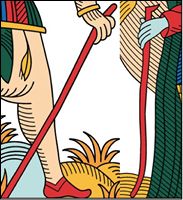
Fig. 24
The two Wands
Let us consider again the cards of the House of God and of the Moon:
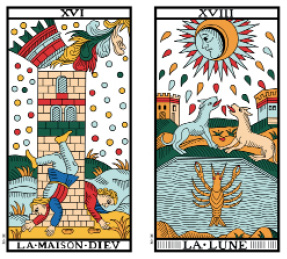
Fig. 25
House of God - Moon
We have already said that there exists a symbol common to both, the tower. Actually, in ancient times the tower was the equivalent of a house because at one time the towers were inhabited. In the first cards, the name Maison Diev ( House of God ) is certainly not casual. In these two Arcana, the house is represented twice: why? In order to explain this, we must mention another concept. In each of these Icons, a certain number of keywords exists. These concepts are deducible by observation of both the illustrations, as by the deeper and more esoterical understanding provided by the Codes. Otherwise expressed, observing and decoding the symbolism of the Tarot, we discover certain essential Ideas , which may be used in various ways, one of these being practical interpretation.
In the Fool, for example, it would be natural to think of the verb, “to walk, to go”. Neither is it unreasonable to hypothesize that the keyword of Arcanum XII might be “tied” (because of the cord). From observation of the characteristic of the World, instead, we may deduce the concept of “to be free”. All of these are logical consequences generated by pure observation. We know already that in the cards XVI and XVIII, the presence of the same symbol suggests the notion of something relevant, more so as the idea is expressed as well by the dimensions of the illustration. In fact, as a child would draw a house (let us remember the gaze of the child...), the House of God in particular is much more imposing with respect to the other symbols. What does it mean when a child draws something in this manner? Independently of the fact that it may be a man, an animal or an object, it means that that something is important to him. The same is true here, where the house is large because it has great value... In this way, it is possible to understand two aspects:
1. the house is among the essential concepts of the two cards;
2. the House, the Maison, has an important function for the Tarot.
Thus, this symbol is a keyword of both Arcana, although it is usable with two different modalities given the graphical differences of the two images. Why are we explaining all this?
Let us imagine needing to give an answer to a consultant, who asks us,
“Should I go to live in a certain house?”
Let us observe the following three cards, keeping in mind a very important concept:
When the Arcana are extracted right side up, they present no problems or blockages.
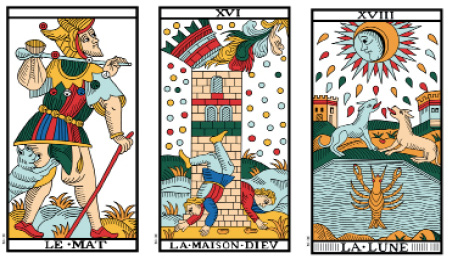
Fig. 26
Going to live in a house
The House of God and the Moon contain the same keywords as the question, exactly as if the Tarot were replying with a brief phrase: to go into the house presents no blocks or problems ... Is that not surprising?
We have already seen that if an element appears twice in the 3x7 Diagram, it is of great interest. This happens also in practical readings. When the tarologist observes the same symbol in two side-by-side blades, he understands that the Tarot, with respect to the specific question of the consultant, is telling him, “ Attention! The keyword here is of GREAT INTEREST. ” For this, it is underlined by a double presence, where a single case would not cause the same “suspicion”. It is simply the strength of repetition or, in Latin, the repetita iuvant which, in this case, helps the Tarologist to understand... 71
We imagine that these affirmations of ours will lead to an interminable series of questions and doubts. It would seem legitimate to ask the question, “ Does the Tarot really answer in this manner? It isn’t possible...! ” In any case, even if we reserve the right to produce new considerations and demonstrations, it is necessary to understand as of now that the only real way to give a definitive answer to this or other perplexities, is practical experience, the royal road to verification of the functioning of the Tarot. Now, our purpose is to illustrate the presence of rules, such as the Law of Antithesis, of Duplicity, of Difference , which are only a part of all those present in the Tarot. To conclude, therefore, let us remember that if we reason simply upon the fact that in the Fool and the Hermit there is a red wand or that in the couple of Arcana XII-XXI there is total opposition, we find ourselves on the “plane of CODES”: The CODE of the Red Wand, the CODE of inversion, Hanged Man-World”, etc. These are unique and isolated events. When instead we find that theses Codes obey certain rules (in this case the Law of Duplicity and the Law of Antithesis ), we find ourselves at the level of a “LAW of the Tarot”, in the repetitive schemes of association of symbols or concepts found so frequently in these cards.
We are aware of the difficulties and the absolute novelty of this way of proceeding, so far from anything ever written or said. For this reason, we consider it a good idea to continue with still more explanations, which may improve the global comprehension of this elaborate Science.